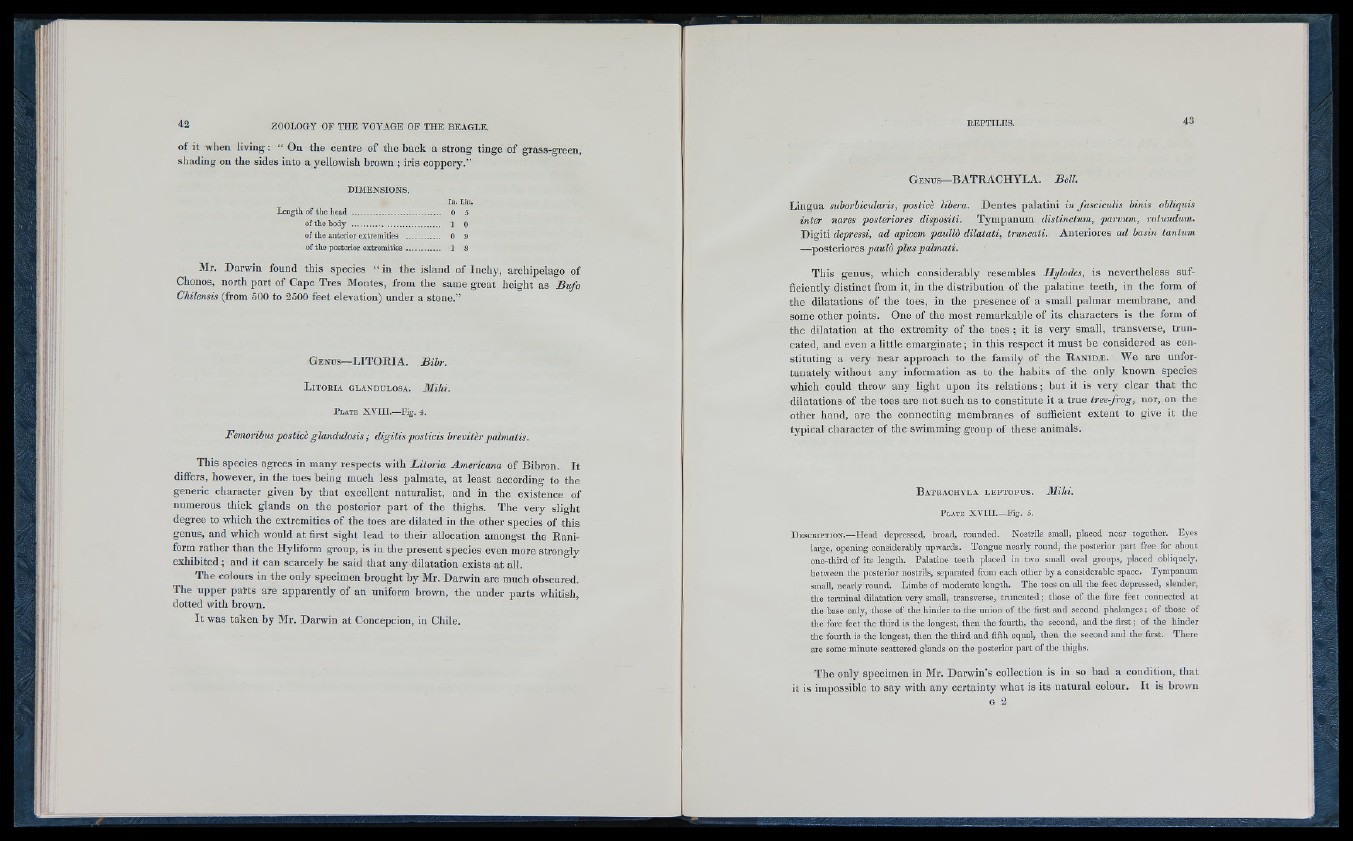
of it when living: “ On the centre of the b a ck a strong tinge of grass-green,
shading on the sides into a yellowish brown ; iris coppery.”
DIMENSIONS.
In. Lin.
Length of the head ............................................ 0 5
of the body ........................................... l 0
of the anterior extremities ................ 0 9
of the posterior extremities ................ 1 8
Mr. Darwin found tliis species “ in the island of Inchy, archipelago of
Chonos, north part of Cape Tres Montes, from the same great height as Bufo
Chilensis (from 500 to 2500 feet elevation) under a stone.”
G e n u s— LITO R IA , Bihr.
L i t o r i a g l a n d u l o s a . Mihi.
PlATB X v m .—Fig. 1.
Femoribus posticè glandulosis ; digitis posticis hrevitèr palmatis.
This species agrees in many respects with Litoria Americana of Bibron. I t
differs, however, in the toes being much less palmate, at least according to the
generic character given by th a t excellent naturalist, and in the existence of
numerous thick glands on the posterior p a rt of the thighs. The very slight
degree to which the extremities of the toes are dilated in the other species of this
genus, and which would at first sight lead to their allocation amongst the Raniform
rather than the Hyliform group, is in the present species even more strongly
exhibited ; and it can scarcely be said th a t any dilatation exists a t all.
The colours in the only specimen brought by Mr. Darwin are much obscured.
The upper parts are apparently of an uniform brown, the under parts whitish,
dotted with brown.
I t w'as taken by Mr. Darwin at Concepcion, in Chile.
G e n u s— BATRACHYLA. Bell.
Lingua suhorhicularis, posticè libera. Dentes palatini in fasciculis binis obliquis
inter nares postei'iores dispositi. Tympanum distinctum, parvum, rotundum.
Digiti depressi, ad apicem paulld dilatati, truncati. Anteriores ad basin tantum
—posteriores pauló plus palmati.
This genus, which considerably resembles Hylodes, is nevertheless sufficiently
distinct from it, in the distribution of the palatine teeth, in the form of
the dilatations of the toes, in the presence of a small palmar membrane, and
some other points. One of the most remarkable of its characters is the form of
the dilatation a t the extremity of the toes ; it is very small, transverse, tru n cated,
and even a little emarginate ; in this respect it must be considered as constituting
a very near approach to the family of the R a n i d æ . We are unfortunately
without any information as to the habits of the only known species
which could throw any light upon its relations; but it is very clear th a t the
dilatations of the toes are not such as to constitute it a true tree-frog, nor, on tlie
other hand, are the connecting membranes of sufficient extent to give it the
typical character of the swimming group of these animals.
B a t r a c h y l a l e p t o p u s . 3Iihi.
P l .\.t e X V I IL—F ig . 5.
D e sc r ip t io n .—H e a d depressed, broad, ro u n d ed . Nostrils small, p lac ed n e a r together. Eyes
large, opening considerably upwards. T o n g u e n ea rly ro u n d , tb e p o sterio r p a r t free for about
o n e -tb ird o f its len g th . P a la tin e te e th placed in two small oval groups, p lac ed obliquely,
b etwe en th e posterior nostrils, sep a rate d from each o th e r b y a considerable space. T ym p an um
small, n ea rly ro u n d . Limbs o f moderate len g th . T h e toes on all th e fe et depressed, slender,
th e term in al d ilatatio n very small, transverse, tru n c a te d ; those o f th e fore fe et conne cted a t
th e base only, those o f tb e b in d e r to tb e u n io n o f tb e first a n d second p h a la n g e s ; o f those of
tb e fore fe et tb e th ird is th e longest, th e n tb e fourth, tb e second, an d tb e firs t; o f th e b in d e r
tb e fo u rth is th e longest, th e n tb e th ird an d fifth equal, th e n tb e second an d tb e first. T h e re
are some m in u te sca tte red glands on tb e posterior p a r t o f tb e thighs.
The only specimen in Mr. Darwin’s collection is in so bad a condition, that
it is impossible to say with any certainty what is its natural colour. I t is brown